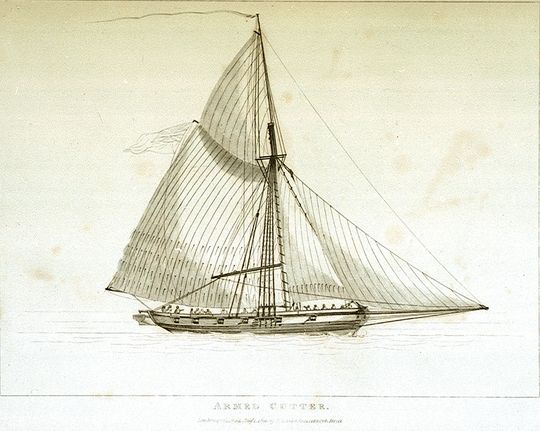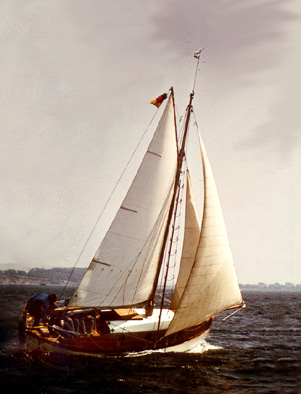|
Hired Armed Cutter Saint Vincent
''St Vincent'' was a hired armed cutter that served the Royal Navy from 16 March 1798 to 29 April 1802, during the French Revolutionary Wars. She was of 194 13/94 tons burthen, and carried fourteen 6-pounder guns. In 1800 she was under the command of Lieutenant John Leckle, (also Leekly or Lackey) at Falmouth. She was employed in cruising in search of privateers and escorting convoys to and from the Downs. She arrived at Portsmouth on 12 July and sailed for a cruise off Cherbourg. She returned on 20 August with a prize, the Danish galiot ''Friendship'', laden with merchandise and bound for Lisbon from Amsterdam. On 25 August, the 74-gun ''Impétueux'', the 28-gun frigate , 16-gun ship-sloop and the 14-gun hired cutter ''St Vincent'' silenced a battery that was armed with eight 24-pounders. Then seamen from the ships landed to assist a large force of army troops to haul the guns up to the heights. The army withdrew the same day after a skirmish with Spanish troops. '' ... [...More Info...] [...Related Items...] OR: [Wikipedia] [Google] [Baidu] |
Hired Armed Vessels
During the eighteenth and nineteenth centuries the Royal Navy made use of a considerable number of hired armed vessels. These were generally smaller vessels, often cutters and luggers, that the Navy used for duties ranging from carrying and passengers to convoy escort, particularly in British coastal waters, and reconnaissance.Winfield (2008), p.387. Doctrine The Navy Board usually hired the vessel complete with master and crew rather than bareboat. Contracts were for a specified time or on an open-ended monthly hire basis. During periods of peace, such as the period between the Treaty of Amiens and the commencement of the Napoleonic Wars, the Admiralty returned the vessels to their owners, only to rehire many on the outbreak of war. The Admiralty provided a regular naval officer, usually a lieutenant for the small vessels, to be the commander. The civilian master then served as the sailing master. For purposes of prize money or salvage, hired armed vessels received the sa ... [...More Info...] [...Related Items...] OR: [Wikipedia] [Google] [Baidu] |
Cutter (boat)
A cutter is a type of watercraft. The term has several meanings. It can apply to the rig (or Sail plan, sailplan) of a sailing vessel (but with regional differences in definition), to a governmental enforcement agency vessel (such as a coast guard or border force cutter), to a type of ship's boat which can be used under sail or oars, or, historically, to a type of fast-sailing vessel introduced in the 18th century, some of which were used as small warships. As a sailing rig, a cutter is a single-masted boat, with two or more headsails. On the eastern side of the Atlantic Ocean, Atlantic, the two headsails on a single mast is the fullest extent of the modern definition. In U.S. waters, a greater level of complexity applies, with the placement of the mast and the rigging details of the bowsprit taken into account so a boat with two headsails may be classed as a sloop. Government agencies use the term "cutter" for vessels employed in patrolling their territorial waters and other ... [...More Info...] [...Related Items...] OR: [Wikipedia] [Google] [Baidu] |
Royal Navy
The Royal Navy (RN) is the United Kingdom's naval warfare force. Although warships were used by Kingdom of England, English and Kingdom of Scotland, Scottish kings from the early medieval period, the first major maritime engagements were fought in the Hundred Years' War against Kingdom of France, France. The modern Royal Navy traces its origins to the early 16th century; the oldest of the British Armed Forces, UK's armed services, it is consequently known as the Senior Service. From the middle decades of the 17th century, and through the 18th century, the Royal Navy vied with the Dutch Navy and later with the French Navy for maritime supremacy. From the mid 18th century, it was the world's most powerful navy until the World War II, Second World War. The Royal Navy played a key part in establishing and defending the British Empire, and four Imperial fortress colonies and a string of imperial bases and coaling stations secured the Royal Navy's ability to assert naval superiority ... [...More Info...] [...Related Items...] OR: [Wikipedia] [Google] [Baidu] |
French Revolutionary Wars
The French Revolutionary Wars (french: Guerres de la Révolution française) were a series of sweeping military conflicts lasting from 1792 until 1802 and resulting from the French Revolution. They pitted France against Britain, Austria, Prussia, Russia, and several other monarchies. They are divided in two periods: the War of the First Coalition (1792–97) and the War of the Second Coalition (1798–1802). Initially confined to Europe, the fighting gradually assumed a global dimension. After a decade of constant warfare and aggressive diplomacy, France had conquered territories in the Italian Peninsula, the Low Countries and the Rhineland in Europe and abandoned Louisiana in North America. French success in these conflicts ensured the spread of revolutionary principles over much of Europe. As early as 1791, the other monarchies of Europe looked with outrage at the revolution and its upheavals; and they considered whether they should intervene, either in support of King ... [...More Info...] [...Related Items...] OR: [Wikipedia] [Google] [Baidu] |
Builder's Old Measurement
Builder's Old Measurement (BOM, bm, OM, and o.m.) is the method used in England from approximately 1650 to 1849 for calculating the cargo capacity of a ship. It is a volumetric measurement of cubic capacity. It estimated the tonnage of a ship based on length and maximum beam. It is expressed in "tons burden" ( en-em , burthen , enm , byrthen ), and abbreviated "tons bm". The formula is: : \text = \frac where: * ''Length'' is the length, in feet, from the stem to the sternpost; * '' Beam'' is the maximum beam, in feet. The Builder's Old Measurement formula remained in effect until the advent of steam propulsion. Steamships required a different method of estimating tonnage, because the ratio of length to beam was larger and a significant volume of internal space was used for boilers and machinery. In 1849, the Moorsom System was created in the United Kingdom. The Moorsom system calculates the cargo-carrying capacity in cubic feet, another method of volumetric measurem ... [...More Info...] [...Related Items...] OR: [Wikipedia] [Google] [Baidu] |
Galiot
A galiot, galliot or galiote, was a small galley boat propelled by sail or oars. There are three different types of naval galiots that sailed on different seas. A ''galiote'' was a type of French flat-bottom river boat or barge and also a flat-bottomed boat with a simple sail for transporting wine. Naval vessels * Mediterranean, (16th–17th centuries) : Historically, a galiot was a type of ship with oars, also known as a half-galley, then, from the 17th century forward, a ship with sails and oars. As used by the Barbary pirates against the Republic of Venice, a galiot had two masts and about 16 pairs of oars. Warships of the type typically carried between two and ten cannons of small caliber, and between 50 and 150 men. It was a Barbary galiot, captained by Barbarossa I, that captured two Papal vessels in 1504. * North Sea (17th–19th centuries) : A galiot was a type of Dutch or German merchant ship of 20 to 400 tons ( bm), similar to a ketch, with a rounded fore and aft ... [...More Info...] [...Related Items...] OR: [Wikipedia] [Google] [Baidu] |
French Ship America (1788)
''America'' was a 74-gun ship of the line of the French Navy. The Royal Navy captured her in 1794 at the Battle of the Glorious First of June. She then served with the British under the name HMS ''Impetueux'' until she was broken up in 1813. She became the prototype for the Royal Navy . Capture The vessel was captured by at the Battle of the Glorious First of June. In 1795 the Admiralty renamed her HMS ''Impétueux'' as there was already a ship named ''America'' in the British navy. British service On 5 October 1796, Captain John Willet Payne was given command. After a refit at Portsmouth, she sailed for Spithead on 11 October, where her refit continued until she sailed on English Channel duty on 28 October, returning to Spithead on 1 January 1797. In that year Payne resigned his commission through ill-health and Captain Sampson Edwards assumed command. On 8 March 1797, ''Impetueux'' captured ''Vautour'', a privateer cutter from an unknown harbour, commissioned in early 1 ... [...More Info...] [...Related Items...] OR: [Wikipedia] [Google] [Baidu] |
William James (naval Historian)
William James (1780 – 28 May 1827) was a British lawyer and military historian who wrote important histories of the military engagements of the British with the French and Americans from 1793 through the 1820s. Career Although little is known of his early life, William James was trained in the law and began his career as an attorney. He practised before the Supreme Court of Jamaica and served as a proctor in the Vice-Admiralty Court of Jamaica from 1801 to 1813. In 1812, when war broke out between Great Britain and the United States, James was in the United States. Detained by American authorities as a British national, he escaped to Halifax, Nova Scotia, in 1813. This experience interested him in the War of 1812 and he began to write about it, particularly defending the reputation of the Royal Navy and pointing out the factual errors and excessive claims that American reports made against the Royal Navy. His initial literary efforts seem to have been letters written to the ... [...More Info...] [...Related Items...] OR: [Wikipedia] [Google] [Baidu] |
Hired Armed Cutter Earl Spencer
Three hired armed cutters named ''Earl Spencer'' served the British Royal Navy during the French Revolutionary or Napoleonic Wars. Two, both cutters, served at the same time between 1799 and 1801. A third, variously referred to as a tender or cutter, served from 1803 to 1814. ''Earl Spencer'' (1) ''Earl Spencer'', of 163 tons ( bm) served under contract between 7 July 1799 and 20 October 1801. She carried two 6-pounder guns and twelve 12-pounder carronades. At some point in early 1800, ''Earl Spencer'' and the hired armed cutter ''Nile'' recaptured ''Molly'', which was in ballast. This was probably ''Molley'', which had been sailing from Exeter to Newcastle when a French privateer had captured her. ''Molley'' came into Deal on 14 February. On 11 April ''Earl Spencer'' brought into the Downs the Danish East Indiaman ''Dintelle Catherina'', Andrew Leistner, master. She had been on here way to Copenhagen from Tranquebar when she was detained. She was liberated the next day and th ... [...More Info...] [...Related Items...] OR: [Wikipedia] [Google] [Baidu] |
First Lieutenant
First lieutenant is a commissioned officer military rank in many armed forces; in some forces, it is an appointment. The rank of lieutenant has different meanings in different military formations, but in most forces it is sub-divided into a senior (first lieutenant) and junior (second lieutenant) rank. The NATO equivalent rank for land force officers is OF-1 rank. In navies, while certain rank insignia may carry the name lieutenant, the term may also be used to relate to a particular post or duty, rather than a rank. Indonesia In Indonesia, "first lieutenant" is known as ''Letnan Satu'' (''Lettu''), Indonesian National Armed Forces uses this rank across all three of its services. It is just above the rank of second lieutenant and just below the rank of captain. Israel In the Israel Defense Forces, the rank above second lieutenant is simply lieutenant. The rank of (קצין מקצועי אקדמאי (קמ"א (''katsín miktsoí akademai'' or "kama"), a professional ac ... [...More Info...] [...Related Items...] OR: [Wikipedia] [Google] [Baidu] |


